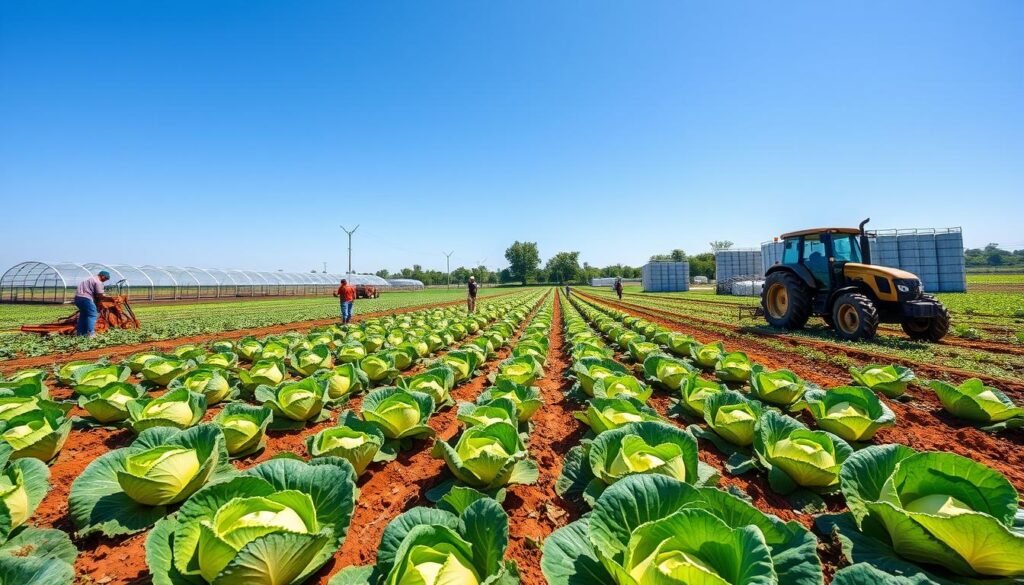Cabbage is a versatile and nutritious vegetable loved by many. It belongs to the Brassicaceae family, like kale and cauliflower. It’s packed with calcium, iron, vitamins A, C, and E, and more, making it a nutritional powerhouse.
To grow cabbage on a large scale, you need to know a lot. This includes soil prep, irrigation, pest control, and how to process it after harvest. In this guide, we’ll cover all these topics to help you grow cabbage efficiently and profitably.
Key Takeaways
- Learn about different cabbage varieties and their needs to improve yields and meet market demands.
- Use the right soil prep and field management to create the best environment for cabbage.
- Try new irrigation and fertilisation methods to increase productivity and use resources wisely.
- Develop plans to manage pests and diseases to protect your crops and follow food safety rules.
- Improve your post-harvest process, including washing, grading, storage, and packaging, to keep your cabbage fresh.
Let’s explore large-scale cabbage farming. A big question is: What makes some cabbage farms more profitable than others? The answer is a mix of good farming practices, technology, and smart decisions. We’ll discover these in our detailed guide.
Understanding Cabbage Varieties for Commercial Production
Choosing the right cabbage varieties is key for big farms. There’s everything from the classic Copenhagen Market to new F1 hybrids. Growers have many options to boost their brassica crop management.
Popular F1 Hybrid Varieties for Large Operations
Top F1 hybrid cabbage varieties for big farms include Gloria F1, Blue Dynasty F1, and Green Challenger F1. Also, Pruktor F1 and Riana F1 are great choices. These hybrids offer fast growth, better disease fight, and high yields.
Selection Criteria Based on Market Demand
Growers must think about what the market wants when picking cabbage varieties. Things like head size, weight, and colour matter a lot. By picking varieties that match market needs, farmers can do well in business.
Regional Adaptability Considerations
Weather in different areas affects which cabbage varieties grow best. Farmers need to pick varieties that fit their local weather, soil, and climate. This way, they can get the best from their crops.
“Profitable crops of cabbage can be produced on a great variety of soils when properly enriched and managed.”
Soil Preparation and Field Management
Starting a cabbage farm needs careful soil prep and field management. Cabbages grow best in well-drained, loamy soil. We make permanent raised beds to help with drainage and air.
We use black silage tarps to stop weeds and keep the soil healthy. We also rotate crops to fight diseases and pests. This keeps the soil rich and fertile.
- Cabbage germinates at a minimum soil temperature of 4°C, with an optimum range between 18°C and 35°C.
- The crop is generally frost resistant, making it suitable for cultivation in a variety of climates.
- Recommended soil pH levels for cabbage production range from 6.0 to 6.5.
Planning our cabbage crops is key. We follow a five-step process to plan our plantings well. This helps us use space and time wisely, making our farm more productive.
| Key Considerations for Cabbage Crop Planning | Recommendations |
|---|---|
| Plant Populations | Loose head market: 26,000 to 30,000 plants/haBagging or chain-store market: 35,000 to 45,000 plants/ha |
| Seedling Transplanting | Seedlings should be grown in a well-aerated medium with good water holding capacity and a pH around 6.5.Transplant seedlings after 4-6 weeks in the nursery. |
| Spacing Guidelines | Loose head market: 60-70cm x 60cmBagging or chain-store market: 45-55cm x 60cm |
| Fertiliser Requirements | Nitrogen: 180-250 kg/haPhosphorus: 50 kg/haPotassium: 120-180 kg/ha |
| Irrigation Needs | Total water requirement: approximately 440mmIdeal weekly application: 1-1.5 inches |
By carefully planning our cabbage crop and using the right soil prep, we get a great harvest every season.

Cabbage Farming Techniques, Large-scale Cabbage Cultivation
To grow cabbage on a big scale, you need to know about good soil prep, smart watering, and the right fertilisers. These steps help get the best yield and quality from your cabbage.
Pre-planting Cultural Practices
Getting the soil ready is key for growing cabbage well. First, test the soil to see what nutrients it has and its pH level. Then, add organic matter like compost. Finally, make the seedbed perfect for seeds to grow well.
Advanced Irrigation Methods
Cabbage needs a lot of water as it grows. Using drip irrigation is a smart way to save water. It makes sure the plants get enough moisture to grow strong.
Fertilisation Strategies for Maximum Yield
Creating a good fertiliser plan is vital for high cabbage yields. Use the right mix of nutrients like nitrogen, phosphorus, and potassium. This helps the plants grow big and strong.
Also, spacing is important for growing cabbage on a large scale. For example, Gloria F1 needs 60 cm x 60 cm space, while Copenhagen Market needs 60 cm x 45 cm. Following these spaces helps the cabbage heads grow well.
“Practices like adding compost to the soil, using organic mulch, implementing cover crops, and practicing crop rotation can enhance soil health, reducing the reliance on traditional fertilizers.”
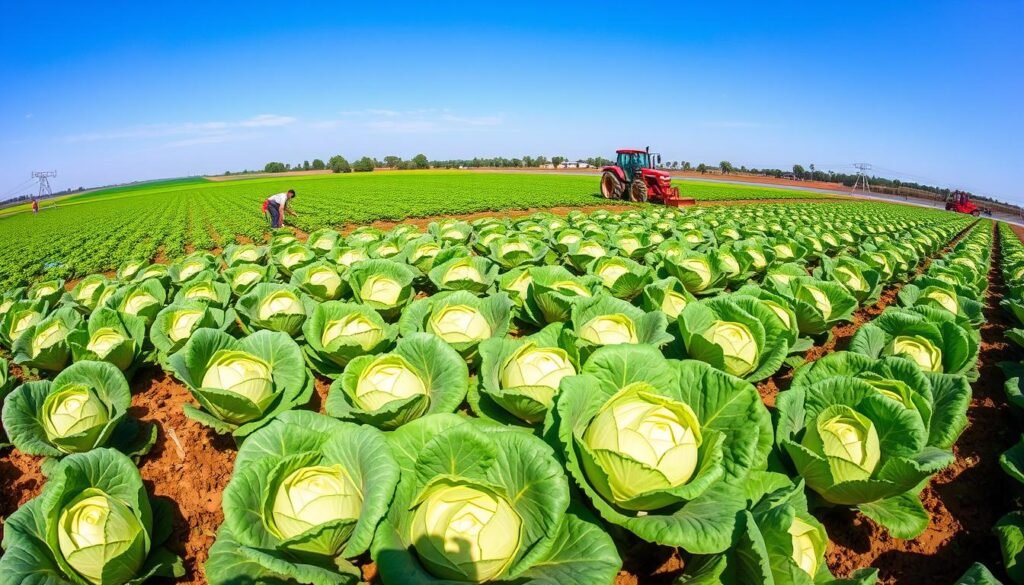
By learning about soil prep, watering, and fertilisers, big cabbage farms can always have plenty of harvests. This meets the demand for this healthy and tasty veggie.
Integrated Pest and Disease Management
Effective management of pests and diseases is key for large-scale cabbage farming. Cabbage faces threats like Black Rot, Cabbage Ring Spot, Diamond Back Moth (DBM), and Fusarium Yellows. Understanding and tackling these issues helps keep our cabbage crops healthy and boosts yields.
Many F1 hybrid cabbage varieties are resistant to these common problems. For example, Blue Dynasty F1 cabbage is resistant to Black Rot, Cabbage Ring Spot, DBM, and Fusarium Yellows. Using these strong varieties is a vital part of our pest management plan.
We also use biopesticides when needed, alongside cultural controls. It’s important to handle and apply biopesticides correctly, following the recommended guidelines. This balanced method helps us manage pests and diseases well, keeping our produce safe and the environment protected.
| Pest/Disease | Management Strategies |
|---|---|
| Black Rot | Use resistant varieties, practise crop rotation, and apply biopesticides as needed |
| Cabbage Ring Spot | Grow resistant cultivars, maintain proper field sanitation, and utilise biopesticides |
| Diamond Back Moth | Implement Bt-based biopesticides, encourage natural predators, and use pheromone traps |
| Fusarium Yellows | Select resistant varieties, disinfect tools, and apply biopesticides as a preventive measure |
By using resistant varieties, cultural controls, and targeted biopesticides, we manage pests and diseases in cabbage farming. This approach keeps our crops and environment healthy, making cabbage farming sustainable and profitable.

Advanced Irrigation Systems and Water Management
In large-scale cabbage farming, advanced irrigation systems are key. Drip irrigation is especially important for saving water and keeping crops healthy. It delivers water exactly where it’s needed, cutting down on waste.
But, setting up and keeping a drip irrigation system running smoothly takes planning and upkeep. It’s not just about installing it; it’s about making sure it works well over time.
Drip Irrigation Setup and Maintenance
Creating a drip irrigation system for cabbage fields means carefully laying out emitters, tubing, and water sources. This setup forms a network that waters the plants right at their roots. It’s all about getting the water to the right place.
Getting it right from the start and keeping it up is key. You don’t want clogged emitters or water that’s not spread evenly. That can hurt your crops.
Water Quality Requirements
Good water quality is crucial for growing cabbage. Bad water can harm the plants and lower your yields. It’s important to check your water sources and make sure they’re clean.
You might need to filter or treat the water to make it right for your cabbage. This ensures your plants get the best chance to grow.
Irrigation Scheduling Techniques
Getting irrigation right is a big part of managing water in cabbage farming. You need to think about soil moisture, the weather, and how the plants are growing. It’s all about using water wisely.
Using tools like soil moisture sensors and evapotranspiration calculations helps. They help you know exactly when and how much water to give your crops. It’s all about precision.
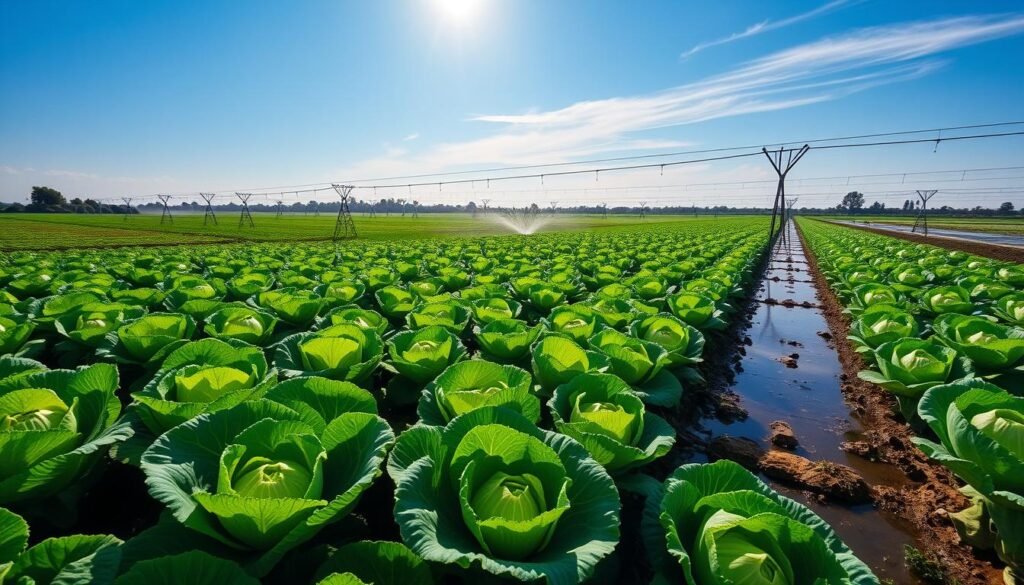
By using these advanced irrigation systems and smart water management, cabbage farmers can do better. They can save water, improve crop health, and increase their yields and profits.
Harvest Timing and Techniques
Getting the timing right for harvesting cabbage is key to getting the best results. Different types of cabbage grow at different rates. Some are ready in as little as 60 days, while others take up to 100 days.
For example, the Green Challenger F1 variety is ready in 60 days. On the other hand, the Riana F1 takes 90-100 days to mature.
How you harvest cabbage is also important. It helps keep the heads in good shape. The weight of the cabbage heads can vary a lot. Riana F1 heads weigh between 1.5-2.5 kg, while Pruktor F1 heads can be as heavy as 5-6 kg.
Some cabbage varieties are much more productive than others. For instance, Pruktor F1 can produce up to 50,000-60,000 kg per acre.
| Variety | Maturity Period (Days) | Average Head Weight (kg) | Yield Potential (kg/acre) |
|---|---|---|---|
| Green Challenger F1 | 60 | 1.5-2.5 | 40,000-50,000 |
| Riana F1 | 90-100 | 1.5-2.5 | 35,000-45,000 |
| Pruktor F1 | 75-90 | 5-6 | 50,000-60,000 |
To get the most out of your cabbage, it’s important to follow good harvesting practices. This means knowing when to harvest and how to do it without damaging the crop. By understanding each variety’s needs, farmers can increase their yields and provide top-quality cabbage to consumers.
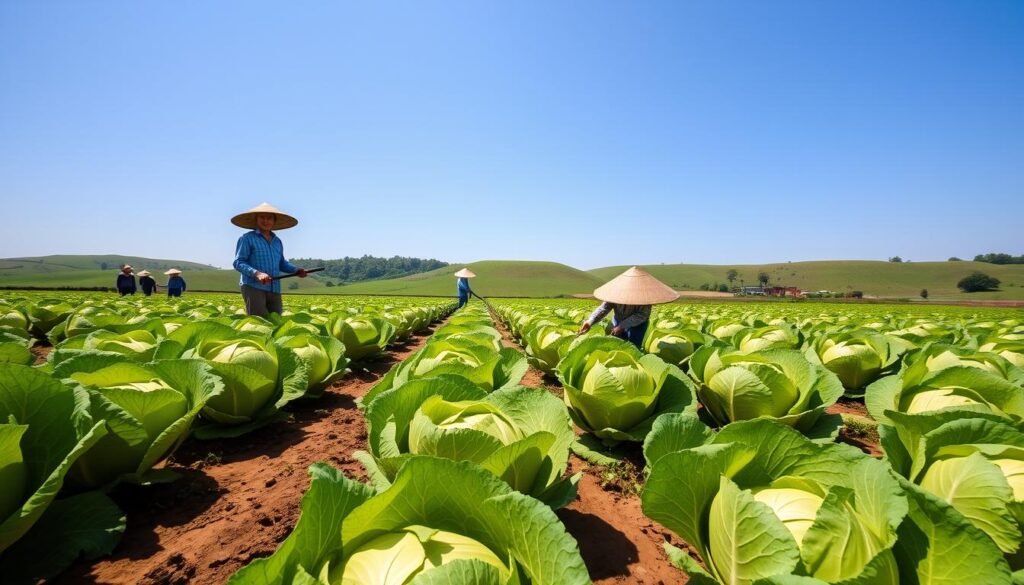
Post-Harvest Processing Operations
Keeping cabbages fresh after they’re picked is key. This means washing, grading, and packing them right. By doing these steps well, farmers can make sure their cabbages are top-notch when they hit the market.
Washing and Grading Systems
Washing cabbages first is vital. Tools like the Air Bubble Vegetable Washer make this step better. They clean cabbages well, getting rid of dirt and other unwanted stuff.
After washing, cabbages are sorted by size, colour, and quality. This makes sure they look good and are consistent for buyers.
Storage Temperature Control
Keeping cabbages cool is crucial. They should be stored at 0°C to 1°C (32°F to 34°F). Also, the air should be 90 to 95 percent humid. This keeps them fresh for longer.
Packaging Solutions
Choosing the right packaging is important. It needs to let air in, protect the cabbage, and meet market needs. For example, the Leaf Vegetable Cutter helps with certain types of packaging.
By focusing on these steps, farmers can improve their cabbage’s quality and appeal. This leads to happier customers and better sales for the farmer.
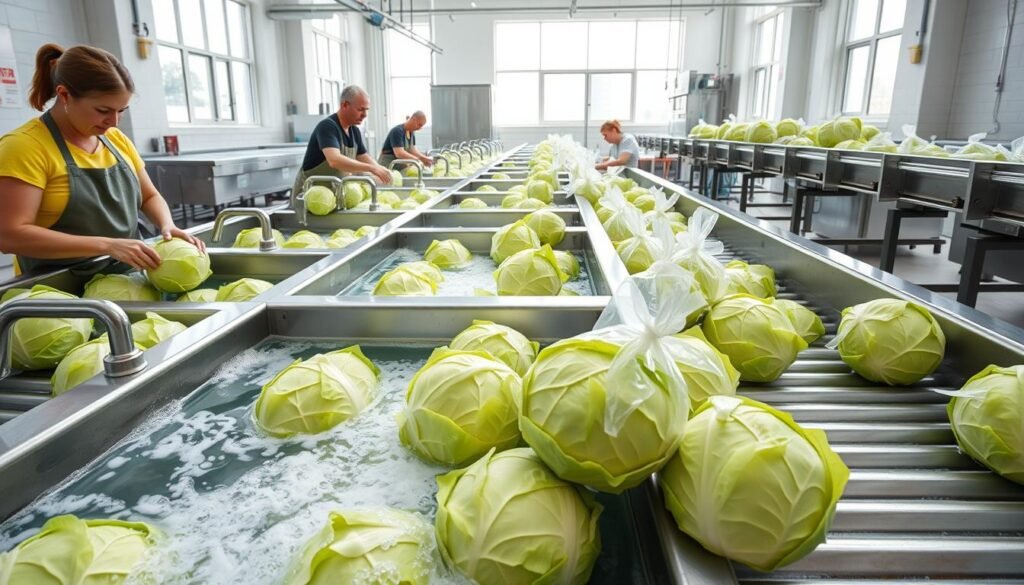
Quality Control and Food Safety Standards
Keeping the highest quality and food safety is key for big cabbage farms. At our farms, we use many steps to follow strict rules and give fresh, safe cabbage to our customers.
We follow Good Manufacturing Practices (GMP) and have a strong Hazard Analysis and Critical Control Points (HACCP) system. This system helps us spot food safety risks, find key control points, and check our work.
We also do regular tests and get certified by trusted labs. We work with the International Organization for Standardization (ISO), the Codex Alimentarius Commission, and local food safety groups. This makes sure our cabbage meets or goes beyond cabbage quality preservation and food safety standards.
| Certification | Significance |
|---|---|
| ISO 22000 | Food safety management system standard |
| Codex Alimentarius | International food standards and guidelines |
| HACCP cabbage | Hazard analysis and critical control points |
By sticking to these strict standards and watching our steps, we make sure our cabbage is top-notch. Our dedication to food safety is more than just following rules. It’s a key part of how we work and builds trust with our customers.
“Robust quality control and food safety measures are the foundation for delivering exceptional produce that consumers can rely on.”
Marketing Strategies and Distribution Channels
For large-scale cabbage farming to succeed, it needs good marketing and various ways to sell. The global cabbage market is set to hit over $9 billion by 2025. Knowing your market and using the right sales channels can make all the difference.
Direct Marketing Options
Direct marketing is a great option for cabbage farmers. They can sell at farmers’ markets, start CSA programs, or sell directly to restaurants. This way, farmers get more money and connect with people who want fresh, healthy food.
Wholesale Market Integration
Getting into the wholesale market is key for big cabbage farms. Building ties with distributors and supermarkets can help sell more. Also, selling processed cabbage products like sauerkraut opens up new chances for farmers.
Online platforms can also help farmers reach more people. It’s important to know what people want and how much they’re willing to pay. This helps farmers make more money and stay competitive.
| Marketing Channel | Target Market | Advantages |
|---|---|---|
| Farmers’ Markets | Health-conscious consumers | Higher profit margins, direct customer relationships |
| Community-Supported Agriculture (CSA) | Subscribers seeking locally grown produce | Guaranteed sales, predictable income, customer loyalty |
| Direct Sales to Restaurants and Institutions | Chefs, schools, hospitals, etc. | Consistent demand, potential for larger orders |
| Wholesale Distributors and Supermarkets | Broader consumer base | Increased market reach, economies of scale |
| E-commerce Platforms | Online shoppers | Expanded customer base, convenience for consumers |
By using many marketing strategies and sales channels, big cabbage farms can make more money. They can also reach more people, meeting the demand for quality, fresh, and sustainable food.
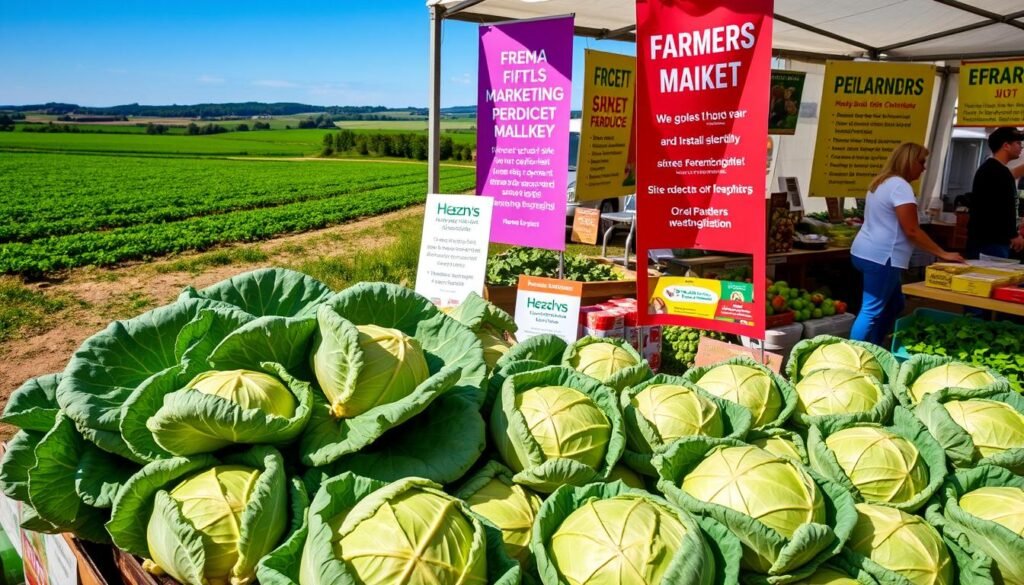
Equipment and Machinery Requirements
Cultivating cabbage on a large scale needs special equipment and machinery. These tools help from soil preparation to post-harvest processing. They make operations more efficient and productive. Let’s look at the key vegetable farm equipment, cabbage farming machinery, and large-scale farming tools for a successful cabbage operation.
Soil Preparation and Planting
Walk-behind tractors like the BCS model are popular for soil preparation. They can till, disc, and form beds easily. For planting, six-row seeders ensure seeds are evenly spread, helping plants grow well.
Weed Management and Cultivation
Weed control is key in cabbage farming. Tools for weed management include manual and powered cultivators. These tools help keep the beds weed-free.
Harvesting and Post-Harvest Processing
Harvesting cabbage heads can be hard work. But, special equipment makes it easier. Mechanical harvesters, like those from Canada, can harvest up to 3,277 cabbages per hour with a team of eight.
After harvesting, special equipment is needed for processing. This includes washing stations, grading systems, and packaging machinery. These tools ensure cabbage heads are clean, sorted, and ready for storage or distribution.
| Equipment/Machinery | Purpose |
|---|---|
| Walk-behind Tractors (BCS Model) | Soil preparation (tilling, discing, bed formation) |
| Six-row Seeders | Accurate and even planting of cabbage seeds |
| Cultivating Tools (Manual and Powered) | Weed management and inter-row cultivation |
| Mechanical Harvesters | Efficient cabbage head harvesting (up to 3,277 heads/hour) |
| Washing Stations, Grading Systems, Packaging Machinery | Post-harvest processing and preparation for storage/distribution |
Keeping equipment in good condition is vital. Following the manufacturer’s guidelines helps ensure it works well for a long time. With the right tools, large-scale cabbage operations can work better, save on labour costs, and increase productivity.
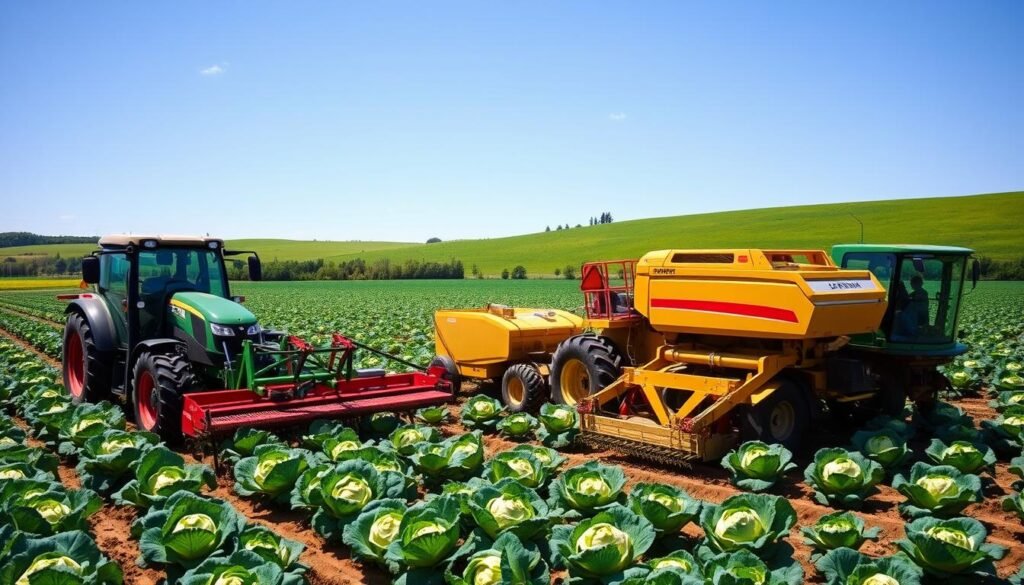
Conclusion
Large-scale cabbage farming needs a detailed plan. It involves choosing the right varieties and using the latest farming and processing methods. Keeping up with trends and technology helps us stay ahead in the fast-changing cabbage market.
Following the best farming practices is key. This includes preparing the soil well and using modern tools for harvesting and processing. With more people wanting organic cabbage, there’s a big chance for farmers to make more money at home and abroad.
Using science and new tech can make the cabbage industry better. We aim to grow more cabbage and meet the changing tastes of people everywhere. Our goal is to keep improving and provide top-quality cabbage to the world.
FAQ
What are the common cabbage varieties used for commercial production?
For commercial cabbage production, you’ll find Gloria F1, Copenhagen Market, and Blue Dynasty F1. Baraka F1, Green Challenger F1, Pruktor F1, and Riana F1 are also popular. Each variety has its own maturity period, head size, and disease resistance.
What are the key considerations for selecting cabbage varieties?
When picking cabbage varieties, think about market demand and disease resistance. Gloria F1 matures in 90 days and yields 30,000-50,000kg per acre. Copenhagen Market matures in 65-70 days and yields 20,000-30,000kg per acre.
How important is soil preparation and field management for successful cabbage cultivation?
Soil preparation and field management are key for growing cabbage. Use permanent raised beds and black silage tarps to control weeds. Crop rotation helps too. Planning your crops well can boost productivity and profits.
What are the key pre-planting practices, irrigation methods, and fertilisation strategies for large-scale cabbage farming?
For large-scale cabbage farming, start with soil testing and composting. Seedbed preparation is also important. Use drip irrigation to save water. Fertilise based on soil tests and crop needs to increase yields.
How important is integrated pest and disease management for cabbage farming?
Managing pests and diseases is vital for cabbage farming. F1 hybrid varieties often resist common problems like Black Rot and Diamond Back Moth. Biopesticides are safe and effective when needed.
What are the benefits of advanced irrigation systems for large-scale cabbage cultivation?
Advanced irrigation, like drip systems, is crucial for cabbage farming. They save water and improve crop health. Setting up and maintaining these systems requires careful planning and regular upkeep.
How important are proper harvest timing and techniques for maximising cabbage yield and quality?
Harvesting cabbage at the right time and using the right techniques is key. Different varieties mature at different times. Harvesting methods should protect the heads. Some varieties, like Pruktor F1, can yield up to 50,000-60,000kg per acre.
What are the key post-harvest processing operations for maintaining cabbage quality?
Keeping cabbage quality high after harvest is essential. This includes washing, grading, and packaging. Advanced washing systems and proper storage are important. Packaging should protect the cabbage from damage.
What are the quality control and food safety standards required for large-scale cabbage operations?
For large-scale cabbage farming, strict quality control and food safety are musts. Follow Good Manufacturing Practices (GMP) and implement HACCP systems. Regular testing and certification are vital for maintaining quality and safety.
What are the effective marketing strategies and distribution channels for large-scale cabbage farming?
Successful cabbage farming needs good marketing and distribution. Use direct marketing like farmers’ markets and CSA programs. Wholesale markets and e-commerce platforms can also help reach more customers.
What specialized equipment and machinery are required for large-scale cabbage farming?
Large-scale cabbage farming needs specific equipment for efficiency. Use walk-behind tractors, six-row seeders, and cultivating tools. Harvesting and post-harvest processing equipment are also crucial. Regular maintenance ensures equipment works well and lasts long.
Source Links
- Slide 1 – https://www.jica.go.jp/project/english/kenya/015/materials/c8h0vm0000f7o8cj-att/materials_21.pdf
- The Market Gardener Masterclass – https://themarketgardener.com/courses/the-market-gardener-masterclass/
- A Project Report on Commercial Cultivation of Cabbage – https://sanjokpoudel.files.wordpress.com/2014/05/project.pdf
- Cabbage – Small Farmer’s Journal – https://smallfarmersjournal.com/cabbage/
- Commercial Production and Management of Cabbage and Leafy Greens – https://extension.uga.edu/publications/detail.html?number=B1181&title=commercial-production-and-management-of-cabbage-and-leafy-greens
- Cabbage Production Guideline 2014 – https://www.starkeayres.com/uploads/files/Cabbage-Production-Guideline-2019.pdf
- Ultimate Guide to Cabbage Farming: From Seed to Harvest – https://www.agrifarming.in/cabbage-farming
- Cabbage Planting Guide | Greenlife | 2024 Update – https://www.greenlife.co.ke/cabbage-planting-guide/
- How to Grow Cabbage: The Complete Guide – https://www.almanac.com/plant/cabbage
- My Complete Guide to Growing Cabbage: From Seed to Harvest – https://www.azurefarmlife.com/farm-blog/guide-to-growing-cabbage
- Cabbage Production in West Africa and IPM with a Focus on Plant-Based Extracts and a Complementary Worldwide Vision – https://pmc.ncbi.nlm.nih.gov/articles/PMC7998567/
- Cabbage, Broccoli, Cauliflower, and Other Brassica Crops : New England Vegetable Management Guide : UMass Amherst – https://nevegetable.org/crops/cabbage-broccoli-cauliflower-and-other-brassica-crops
- Advancing horizons in vegetable cultivation: a journey from ageold practices to high-tech greenhouse cultivation—a review – https://www.ncbi.nlm.nih.gov/pmc/articles/PMC11057267/
- The Effect of Fertigation on Cabbage (Brassica oleracea L. var. capitata) Grown in a Greenhouse – https://www.mdpi.com/2073-4441/12/4/1076
- PDF – https://ageconsearch.umn.edu/record/340664/files/Hatungimana.pdf
- How to Grow a Gigantic Cabbage – https://bonnieplants.com/blogs/garden-fundamentals/grow-gigantic-cabbage
- Fryd – https://fryd.app/en/magazine/planting-growing-harvesting-red-cabbage-tips-for-a-successful-harvest
- How To Grow Cabbage | Harvesting, Planting, and Growing Cabbage – THE SAGE – https://blog.gardenuity.com/how-to-grow-cabbage/
- Flower, leafy and stem vegetables – https://vric.ucdavis.edu/postharvest/leaf.htm
- CabbageCornell Vegetable Program- Cornell University – https://cvp.cce.cornell.edu/crop.php?id=8
- Cole Crop Production (Broccoli, Cabbage, and Cauliflower) – Oklahoma State University – https://extension.okstate.edu/fact-sheets/cole-crop-production.html
- Standards for the Growing, Harvesting, Packing, and Holding of Produce for Human Consumption: Guidance for Industry – https://www.fda.gov/media/117414/download
- Food Safety-Cornell Vegetable Program- Cornell University – https://cvp.cce.cornell.edu/food_safety.php
- The Cabbage Patch: Grow Your Own Green Gold – https://www.linkedin.com/pulse/cabbage-patch-grow-your-own-green-gold-colonel-shantall-ramatsui
- Assessing Production and Marketing Efficiency of Organic Horticultural Commodities: A Stochastic Frontier Analysis – https://www.mdpi.com/2227-7099/12/4/90
- Cabbage Farming Business Plan Template – https://avvale.co.uk/zh/pages/cabbage-farming-business-plan-template?srsltid=AfmBOop9nokETrkrE5Vjnv4XeGiIExsUfsE2txfqe1Es6E_kynFsqpOT
- Cabbages: a step-by-step beginner’s guide – https://www.farmersweekly.co.za/farming-basics/how-to-crop/cabbages-beginners-guide/
- Fabrication and Evaluation of a Cabbage Harvester Prototype – https://www.mdpi.com/2077-0472/10/12/631
- CIR1256/PI042: Florida Crop/Pest Management Profile: Cabbage – https://edis.ifas.ufl.edu/publication/PI042
- PDF – https://iopscience.iop.org/article/10.1088/1755-1315/939/1/012044/pdf
- 5 Proven Techniques To Boost Cabbage Farming Profitability In Mittimind Farms – https://mittimindfarms.com/cabbage-farming/

